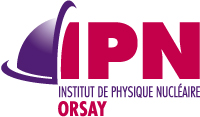Study of baryonic resonances in the channel pp->ppπ⁺π⁻ at 3.5 GeV beam energy with the HADES detector
Etude de résonances baryoniques dans le canal pp->ppπ⁺π⁻ à une énergie de faisceau de 3.5 GeV avec le détecteur HADES
Résumé
The subject of this thesis is the analysis of the pp->ppπ⁺π⁻ reaction measured at a beam energy of 3.5 GeV with the High Acceptance Di-Electron Spectrometer (HADES) at GSI. The aim is to provide additional information on the production of a pion and a kaon measured by HADES for the excitation of a resonance as well as new results for the production of two resonances and the ρ meson production. Such information is important, in particular, for the interpretation of the di-electron spectra measured by the HADES collaboration. The extraction of the signal for pp->ppπ⁺π⁻ production is based on the detection of one proton, one π⁺ and one π⁻ in the HADES detector and the calculation of the missing mass. Statistical errors are negligible and systematic errors are mainly due to the efficiency corrections which are based on simulations and to normalization. A simple model based on PLUTO event generator was built for the interpretation of the data, by including three main types of contributions: the production of one resonance decaying into pπ⁺π⁻ and the excitation of two resonances, decaying respectively into pπ⁺ and pπ⁻ and the direct ρ production. A fitting procedure is developed, using as constraint the information obtained for the single resonance excitation from one pion and one kaon production data. The contribution of the ρ meson was also extracted after applying necessary kinematical cuts. Among all the identified contributions, the main ones are the double Δ(1232) excitation and the N(1520) excitation. A Lagrangian model was developed for these two contributions, the calculations give a similar result to the simple model and predict a negligible interferences effect. Finally, the confrontation of the experimental results to the predictions of existing theoretical models shows the necessity to take into account these new data for the description of mesons and di-electron production in nuclear collisions above 1.5 GeV/nucleus.
Le sujet de cette thèse est l’analyse de la réaction pp->ppπ⁺π⁻ mesurée à une énergie de faisceau de 3,5 GeV avec le spectromètre HADES à GSI. L’objectif est d’apporter des informations complémentaires à la production d'un pion et d'un kaon mesurés par HADES pour l'excitation d'une résonance ainsi que des résultats tout nouveaux pour la production de deux résonances et pour la production du méson ρ. Ces informations sont particulièrement importantes pour l'interprétation des spectres de di-électrons également mesurés par la collaboration HADES. L'extraction du signal pour la production de pp->ppπ⁺π⁻ est basée sur la détection d'un proton, un π⁺ et un π⁻ dans le détecteur HADES et sur le calcul de la masse manquante. Les erreurs statistiques sont négligeables et les erreurs systématiques sont principalement dues aux corrections d’efficacité basées sur des simulations et à la normalisation. Un modèle simple basé sur le générateur d’évènements PLUTO a été construit pour l'interprétation des données en incluant trois types de contributions: la production d’une résonance décroissant en pπ⁺π⁻ et l’excitation de deux résonances décroissant respectivement en pπ⁺ et pπ⁻ et la production directe du méson ρ. Une procédure de fit est développée en utilisant comme contraintes pour l'excitation baryonique simple les résultats obtenus pour la production d'un pion et d'un kaon. La contribution du méson ρ a été également extraite après l’application des coupures cinématiques nécessaires et le rôle des résonances baryoniques dans cette production est discuté. Parmi toutes les contributions identifiées, les principales sont la double excitation de Δ(1232) et la simple excitation de N(1520). Un modèle de Lagrangien a été mis au point pour ces deux contributions, les calculs donnent un résultat assez proche du modèle simple et prédisent un effet des interférences très faible. Finalement, la confrontation des résultats expérimentaux aux prédictions de modèles théoriques existants montre la nécessité de prendre en compte ces nouvelles données pour la description de la production de mésons et de di-électrons dans les collisions nucléaires au-delà de 1.5 GeV/nucléon.
Origine : Version validée par le jury (STAR)


